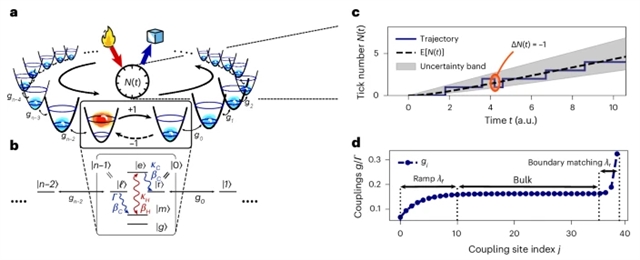
奥地利维也纳技术大学Huber, Marcus团队近日发现了精度不受热力学第二定律的限制。2025年6月2日,《自然—物理学》杂志发表了这一成果。
在不平衡状态下运行的物理设备会受到热波动的影响,从而限制了它们的运行精度。这个问题在微观和量子尺度上尤为明显,在这些尺度上,它的缓解需要额外的熵耗散。理解这一约束对于基础物理学和技术设计都很重要。例如,时钟需要一个朝向平衡的热力学通量来测量时间,从而使每个时钟滴答的熵耗散最小。尽管经典和量子模型通常显示精度和耗散之间存在线性关系,但这种关系的最终界限尚不清楚。
研究组提出了一种自主的量子多体钟模型,该模型实现了随熵耗散呈指数级扩展的时钟精度。这是通过具有定制耦合的自旋链中的相干输运实现的,其中耗散仅限于单个环节。结果表明,相干量子动力学可以超越传统的热力学精度限制,有可能指导未来高精度、低功耗量子器件的发展。
附:英文原文
Title: Precision is not limited by the second law of thermodynamics
Author: Meier, Florian, Minoguchi, Yuri, Sundelin, Simon, Apollaro, Tony J. G., Erker, Paul, Gasparinetti, Simone, Huber, Marcus
Issue&Volume: 2025-06-02
Abstract: Physical devices operating out of equilibrium are affected by thermal fluctuations, limiting their operational precision. This issue is particularly pronounced at microscopic and quantum scales, where its mitigation requires additional entropy dissipation. Understanding this constraint is important for both fundamental physics and technological design. Clocks, for example, need a thermodynamic flux towards equilibrium to measure time, resulting in a minimum entropy dissipation per clock tick. Although classical and quantum models often show a linear relationship between precision and dissipation, the ultimate bounds on this relationship remain unclear. Here we present an autonomous quantum many-body clock model that achieves clock precision that scales exponentially with entropy dissipation. This is enabled by coherent transport in a spin chain with tailored couplings, where dissipation is confined to a single link. The result demonstrates that coherent quantum dynamics can surpass the traditional thermodynamic precision limits, potentially guiding the development of future high-precision, low-dissipation quantum devices.
DOI: 10.1038/s41567-025-02929-2
Source: https://www.nature.com/articles/s41567-025-02929-2
